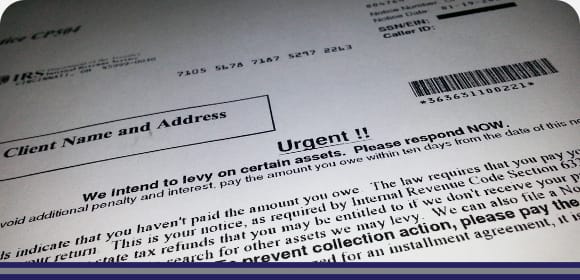The IRS cannot haunt you for your tax debts indefinitely. In some cases, allowing the collection period to expire on the collection of tax is an effective method for obtaining tax relief.
Tax debts are collectible for up to ten years from the date of assessment of the tax, minus suspensions (tolling periods). This is referred to as the IRS Statute of Limitations, with the final date for collection being the Collection Statute Expiration Date (CSED). The “date of assessment” is the date on your Notice of Deficiency, a tax debt bill sent by the IRS informing you of your owed amount. It is not the date on your tax return.
What is the Statute of Limitations on IRS Debt?
After ten years, you reach the Collection Statute Expiration Date (CSED) on your tax debt. However, that ten-year period is subject to certain tolling periods, wherein the clock stops. The IRS technically can’t collect whenever a taxpayer is going through a bankruptcy proceeding, for example, so they stop the clock on the IRS statute of limitations, thus extending the period by however long the bankruptcy took, plus an additional six months.
There are other similar tolling periods and specific dates that must be accounted for if you want to accurately determine when your tax debt can no longer be collected. Situations that trigger the IRS to stop the clock include:
-
- Being abroad for more than six months
- Filing a lawsuit against the IRS
- Military deferment
- Having sent in an Offer in Compromise
- Having your assets held by a court for one reason or another
- Filing for bankruptcy
- Filing an IRS appeal
- Pending installment agreement
Certain things make the clock run, and certain things make the clock stop. Determining the total time the clock has run can be tricky, yet it is essential in knowing whether this type of tax relief is a viable alternative.
Working with a tax professional can give you better, more thorough insights into how long your debt has run, and how much longer it might remain valid, based on your financial and taxpayer history. Keeping an accurate record of the last few years can make this process a lot easier. However, even an estimated date can be better than no date at all.
Because the IRS can no longer collect on a tax debt after it expires, IRS attempts to coerce collection may become more forceful or aggressive as time goes on. The closer you get to your CSED, the more tools the IRS will use to get you to pay your debt. It’s important to note that knowingly avoiding payment of your tax debt may be criminal – so it isn’t a valid strategy in most cases.
However, some people can go multiple years without remembering that they might owe back taxes, and their CSED might come and go before they or the IRS were any wiser. If you owed the IRS money in the 90s, and have since forgotten about your debt, chances are you no longer owe anything (provided you have been keeping up to date with your estimated payments and tax returns ever since).
IRS Statute of Limitations on Tax Refunds
Tax debt expires in just about ten years, with added tolling periods. But there are other statutes of limitation to be aware, especially when it comes to getting the refunds you’re owed.
Whether your refunds come in the form of special refundable tax credits or the amount you’ve overpaid the government through tax withholding, all refunds that you are entitled to will expire after three years from the tax filing deadline of the return they correspond to.
This means that if you were entitled to a refund based on your 2018 tax return filed on April 15, 2019, your deadline for filing a return and claiming said refund was April 15, 2022.
Note that the IRS does change deadlines from time to time, such as during the COVID-19 pandemic, where tax filing deadlines were pushed forward to May 17th. Most years, Tax Day is April 15th. There’s a difference between the filing deadline date, and the year the tax return is based on – a tax return for 2018 will be filed in 2019, and your deadline for claiming a refund on said return will be 2022.
The same goes for an amended return. If you failed to fill out a tax return at any given year, the IRS will penalize you and file a substitute return in your name, albeit without additional exemptions, deductions, or refunds taken into consideration. Filing an amended return can give you one last chance to claim any refunds you were entitled to, but the same statute of limitations applies.
Exemptions to this rule include physical or mental impairment, or other forms of reasonable cause. If you had good reasons for failing to claim a refund or file another return on time, be sure to contact a tax professional to represent you and make your case against the IRS. Don’t lose out on the tax refunds you deserve!
IRS Statute of Limitations on Tax Audits
The IRS has a strict time limit on when an IRS investigation into any given tax return must be completed. In other words, regardless of when the IRS begins to investigate a return, there is a deadline at which point they must have made a judgment on said return. That deadline is also three years.
This means that a tax return filed on April 15, 2022, must have been completely audited by April 15, 2025. There are a few exceptions to this rule, notably potential tax fraud or criminal activity. But if the IRS decides to look into a math error and doesn’t come to a judgment on your tax account before the three-year mark, you won’t have much to worry about for that year’s tax return.
The timeline for an IRS audit will depend on the type of investigation the IRS launches. Most IRS audits are simple correspondence audits and take no more than a few months. Some IRS audits are more serious and can take over a year. Regardless of how long the IRS takes, the deadline is for the conclusion of the audit, not the beginning. This means there is always a hard timer on when the IRS must finish investigating your returns.
State tax agencies follow similar rules when it comes to auditing tax returns, with just a few exceptions where states have longer statutes of limitation.
IRS Statute of Limitations and Resolutions

Most tax resolution firms that push “Offers in Compromise, Pennies on the Dollar” will not necessarily explain this option to a taxpayer. We believe the way we can best serve our clients is to give them all of the available options for dealing with a tax debt and give guidance on the likely outcomes of pursuing those options. The best option then materializes for the taxpayer to pursue.
However, it is an extremely delicate solution. If you wish to let your tax debt run out, you must meticulously monitor and keep track of your interactions with the IRS, keep certain information at hand, and consult with tax professionals to accurately determine your CSED.
The IRS may try to pressure a taxpayer into signing a waiver of the 10-year statute of limitations on collections. They may try to garnish your paycheck or bank account and use that as leverage to try to get you to sign. While the IRS isn’t as aggressive in pursuing taxes as it once was, and has several checks and balances in place against it – such as the National Taxpayer Advocate – it is still in their best interest to collect as much as they can before a taxpayer’s debt runs out.
Depending upon your circumstances, and how much time you have left before your CSED, pursuing the statute of limitations on IRS debt as a tax relief option may or may not be in your best interest. If you have only recently been warned of an existing tax debt, waiting ten years might not be a feasible option, especially if the IRS continues to ramp up its efforts to combat the Tax Gap. But if your debt is several years old, it may be time to talk to a tax professional and go through each of your options carefully.
Even if you don’t let the timer run out completely, an older tax debt may have different options. While the IRS will be more desperate to get you to agree to an extension, they may also be more willing to sign an agreement for partial payment if you do not have the financial means to pay off your debt before it expires.
It’s important to be careful no matter what you decide to agree with, especially if your debt is older. Don’t sign anything without going over it with a fine comb with your attorney or tax professional.
What About State Tax Limitations?
States have their own statutes of limitations. While some follow the IRS’s statute of limitations, others have their own rules. California, for example, can pursue a person’s state tax debt for up to 20 years. In Texas, the statute of limitations for collecting state taxes is just three years.
It’s also important to note that information you might find on the topic online could be outdated and is non-specific. There are exceptions to statutes of limitation, particularly when it comes to tax debt. In many cases, negotiating with the IRS comes with the added caveat that your timer for the CSED is pushed back. The same goes for state tax authorities.
Whenever you must deal with a tax authority personally – whether it’s your local government, or the federal government – it is important to seek the proper professional representation and legal counsel. Let us help you.
Knowing all your options for both state and federal tax collection laws is usually the best method for determining which way to go. If you decide to pursue the expiration period, working with a tax professional is critical. It’s easy to oversee a potential tolling period or extension and be forced to deal with a substantial tax debt.
GET HELP NOW!

